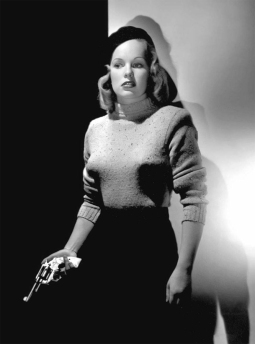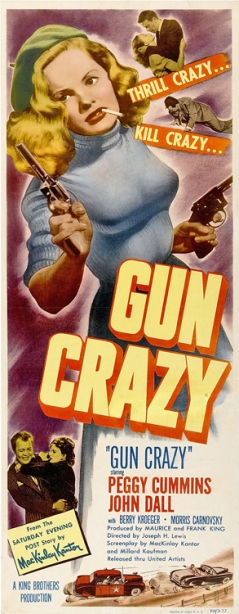Halfway through the 1950 film Gun Crazy, Bart and Annie, dressed in buckskins and cowboy hats and brandishing shiny revolvers, stick up a bank, clobber a lawman, then jump in their car and make tracks out of town.

Peggy Cummins nearly 20 years before Faye Dunaway’s role
In a subsequent scene, actors John Dall and Peggy Cummins are dressed in street clothes, pulling a robbery and trying to make the best of a noir B movie. And they succeed. Backed by direction from Joseph H. Lewis and solid cinematography, the actors lift the film above its station and its average-at-best plot.
In fact this film, unknown outside of hardcore noir fans, is a critics’ choice breakthrough movie. Eddie Muller, TCM’s Noir Alley host and author of a book on Gun Crazy, says the film “is recognized as one of the most dynamic and subversive films of its day.” Another critic called it an “impeccably crafted film… with a razor-sharp screenplay.” I wouldn’t go that far. Yet Gun Crazy can draw you in if you watch closely.
Bart Tare (Dall) and Annie Laurie Starr (Cummins) meet when she’s the trick shooting, western-clad star of a carnival show and he’s an ex-GI World War II vet with a history. During the performance, the show’s manager challenges audience members to try to outshoot the star and win $500. Having grown up fascinated with guns, Bart accepts the challenge. He walks on stage smiling and eager. Is it for the chance to shoot or for the beautiful Cummins’ attractions. He exchanges looks with the sultry shooter then outshoots her, earning himself a permanent place on stage with Annie.
 As we learn in the film’s first scene, Bart became a crack shot through years of shooting bb guns and larger weapons as a child. His obsession with guns—despite abject fear of hurting anyone or anything—leads him to steal a revolver from a store window. He’s caught and sent to reform school before joining the service.
As we learn in the film’s first scene, Bart became a crack shot through years of shooting bb guns and larger weapons as a child. His obsession with guns—despite abject fear of hurting anyone or anything—leads him to steal a revolver from a store window. He’s caught and sent to reform school before joining the service.
Although his shooting prowess puts him on the stage with the six-gun siren, his job is short-lived. The manager who believes he has a hold on Annie becomes jealous when the two sharpshooters start to date, and he fires them.
On the road together Bart suggests marriage and Annie, who he calls Laurie, agrees. In classic B movie fashion they drive up to a dark clapboard building housing a justice of the peace. A large sign proclaims, “Desert justice – Get married.” The building also has signs, “Cocktails, bar, café.” And conveniently next door is the flashing neon sign of a motel.
Soon, however, their money runs out and Laurie suggests robbery. In a cheap hotel room they argue. Bart still fears injuring or killing anyone. Laurie threatens to leave Bart if he doesn’t help her get the kind of money she wants.

How to persuade him to pull a robbery?
This typical crime-movie scene, complete with the blonde Cummins putting on nylon stockings one at a time in front of Bart, gives both actors a chance to strut their stuff. Bart is tortured by the prospect of armed robbery and Laurie is first demanding, then seductive when Bart agrees. She’s lying on the bed in a bathrobe, and when he leans over her the camera focuses on Laurie as she ever-so-slowly parts her lips.
The sexual tension between the two is a dominate part of the film. It’s possible, as a critic suggested, to see the guns the two wield as phallic symbols. Although film conventions of the day limited displays of sexuality—remember, Lucy and Ricky slept in separate beds—Gun Crazy shows you all you need to know. Perhaps this is why Muller says the film is subversive.
Although they share intense desire, it’s Laurie who is closer to personifying the film’s title. She, too, has a history. She accidentally killed someone at a performance. But that doesn’t stop her from continuing to pull the trigger.
Decked out in a skirt, sweater and beret Cummins looks like Bonnie Parker as the duo continue their robbery spree. And this is 19 years before Faye Dunaway donned the hat in Bonnie and Clyde.
As they become famous outlaws, Bart’s misgivings grow. He tells her that he used to think of himself as “a fairly honest guy.”
“You mean, before you met me?” she asks.
“I don’t know. It’s just that everything’s going so fast. It’s all in such high gear,” he says, his anguish palpable, “that sometimes it doesn’t feel like me.”
“When do you think all this?
“At nights. I wake up sometimes. It’s as if none of it really happened, as if nothing were real anymore.”
“Next time you wake up, Bart, look over at me lying there beside you. I’m yours and I’m real.”

Peggy Cummins and John Dall.
Despite a lack of surprises, the film’s combination of lust plus Bart’s fears and Laurie’s instability create opportunities for the actors to act, at times breaking out of the B movie mold.
In a sense this was the pinnacle of Dall’s career. A stage actor, he earned an academy award nomination in his first motion picture and, in 1948, co-starred with Jimmy Stewart and Farley Granger in Hitchcock’s The Rope. Yet he appeared in fewer than a dozen films and died at 51.
The Irish Cummins began her career as a child in films and on stage in the UK. Darryl F. Zanuck brought her to the US where she appeared in a variety of pictures. After Gun Crazy, she returned to Britain where she appeared in films into the 1960s.
Slightly more than halfway through Gun Crazy, Laurie and Bart are holed up in the snow with their car in a ditch. He tells her he’s scared. “I don’t want to be a killer.” She begs him for one more job so they can get out of the country and start over. He agrees setting the stage for their final heist.
Skilled cinematography supplements the film’s pace. The bank robbery scene mentioned earlier, where the duo inexplicably wear cowboy duds, was filmed entirely through the windshield of the pair’s getaway car. The rear of the car was cut away to make room for a camera. From this back-seat vantage point we look over Laurie and Bart’s shoulders as they drive to the bank.
Then Bart goes inside. Soon a patrolman saunters by and Laurie gets out to waylay him just a Bart emerges with the loot. They both get back in the car and drive off, the camera having never moved from its through-the-windshield vantage point. .
The movie ends as you might expect, but in her final close-ups, Cummins surpasses herself. Her face tells the story of the film. Her expression is a mixture of cunning and hyper-excitement. The look in her eyes as the police close in could hardly be reproduced except by someone who was truly (gun) crazy.
Great review! You would make a good author.
L.
LikeLike